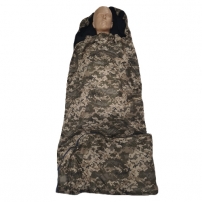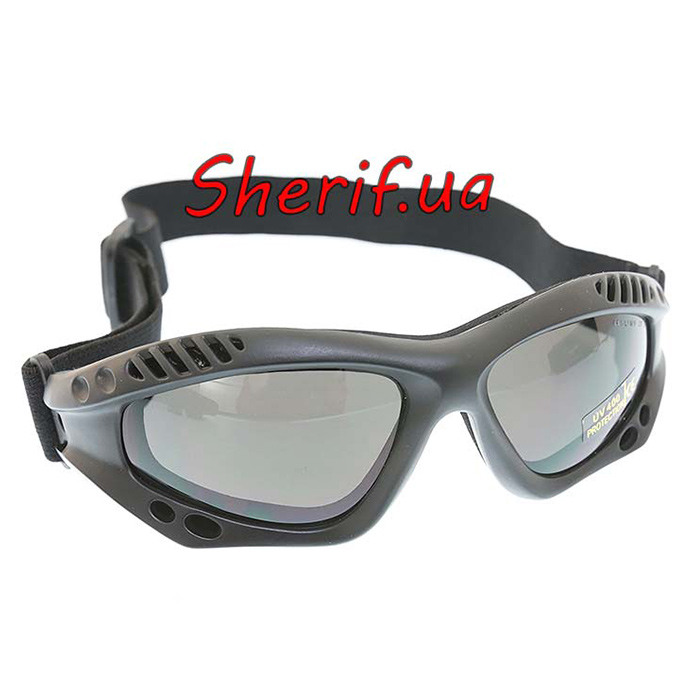* Спальні мішки







| Продолжение каталога см. на след.страницах |
1. Призначення спальних мішків
2. Утеплювач
3. Форма
4. Сезонність та температурний режим
5 Розмір
6. Рекомендації щодо використання
7. Рекомендації щодо догляду та зберігання
8. Як вибрати
9. Де купити
Спальний мішок – абсолютно необхідний предмет для будь-якої ночівлі на природі, якщо, звичайно, Ви хочете при цьому облаштуватись із зручністю, а не перевірити себе на виживання у скрутних умовах. І вибір його потребує деяких знань, оскільки різновидів спальників досить багато, і різницю між ними проводять у різноманітних аспектах.
1. Призначення спального мішка
Перш за все, з'ясуйте для себе, в яких обставинах Ви збираєтеся застосовувати цю турліжко. Бувають такі варіанти:
· Кемпінг . У цьому випадку все, що Вас має цікавити - це тепло спальника . Оскільки довезти все один раз і потім зупинитися надовго на одному місці – завдання не надто складне, то вага, об'ємність можуть не дуже хвилювати. Можна дозволити собі просторі та товсті двоспальні мішки для сімейної пари, що звикла лежати під однією ковдрою, та багато інших розкошів.
· Пікнік на вихідні . Тут все ще простіше, ніж у попередньому випадку, адже на одну-дві ночі брати із собою потрібно набагато менше.
· Похід . А ось тут слід враховувати дуже багато факторів. Чи зручно буде носити обраний спальний мішок у рюкзаку, де буде ще безліч всього потрібного? Чи займе він занадто багато місця? Чи нема в ньому неприпустимих зайвих грамів? (До речі, в нашій колекції є чудовий компактний спальник вагою всього 700 гр.) Чи добре він просушується, або через пару днів Вам доведеться мерзнути у вологих ганчірках?
· Екстремальний похід . Крім всього перерахованого в попередньому пункті, слід особливе значення надати також водовідштовхувального та термоізолюючого ефектів. І краще не заощаджувати – від цього може залежати життя.
2. Утеплювач у спальному мішку
Наповнювачі, що утеплюють, можна поділити для початку на два типи: натуральні та синтетичні. До першого відносяться:
- Вата підходить для нетривалих турів. Справа в тому, що бавовна легко поглинає вологу. Крім того, він досить важкий і відносно швидко зношується. Перевагою можна вважати дешевизну та гіпоалергенність.
– Пух. З нього роблять найтепліші спальні мішки , призначені для високогірних та арктичних експедицій. Для спекотного і особливо вологого клімату їх краще не використовувати, оскільки гігроскопічність пуху призводить до того, що він може почати гнити. При 25-відсотковому зволоженні втрачається близько 50% теплового захисту. А сохнуть пухові спальники довго.
Штучних матеріалів для утеплення сьогодні є дуже багато. Розглянемо кілька:
- Синтепон найлегший, необ'ємний та дешевий. Мінімальна температура, від якої можна захиститись за його допомогою, – мінус 20° за Цельсієм. Висихає швидко, та й поглинає слабо. Підійде для нестійкої погоди, але відносно теплої для піших подорожей. Може збиватися в грудки від прань - після 15-ї не виключена і втрата властивостей. Залежно від сезону має від одного до чотирьох шарів.
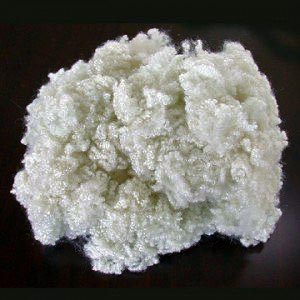 - Поліестер. Дуже низька теплопровідність забезпечує високу теплоізоляцію за дуже малої ваги. Навіть за високої вологості зберігає свої функції. Є різні підтипи волокон даного типу, але вони мають спільні риси: наявність порожнин і спіралеподібна скрученість. Таким чином створюється нетканий пухоподібний матеріал з великою кількістю повітряних прошарків як усередині волокон, так і між ними. Це і холлофайбер, і тинсулейт, і багато інших утеплювачів. Ось чудовий спальник типу «ковдра» з таким наповнювачем.
- Поліестер. Дуже низька теплопровідність забезпечує високу теплоізоляцію за дуже малої ваги. Навіть за високої вологості зберігає свої функції. Є різні підтипи волокон даного типу, але вони мають спільні риси: наявність порожнин і спіралеподібна скрученість. Таким чином створюється нетканий пухоподібний матеріал з великою кількістю повітряних прошарків як усередині волокон, так і між ними. Це і холлофайбер, і тинсулейт, і багато інших утеплювачів. Ось чудовий спальник типу «ковдра» з таким наповнювачем.
– Силікон. Принцип дії той самий – внутрішні канали для повітря. Але силікон ще менше намокає. Тому деякі поліестерові волокна мають силіконову оболонку.
Іноді можна зустріти гібридний утеплювач, у якому природна частина покликана дати більше тепла, а синтезована – підвищити практичність. Приклад, де 90% вовни скріплено 10% синтетики (для запобігання збиванню та скочування), можна подивитися тут .
3. Форма спального мішка
Є дві основні:
· Кокон
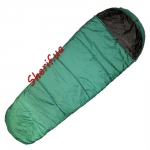 Широкий у плечах і звужується до ніг, ніби повторюючи контур тіла. Це робиться для щільнішого облягання. Причина проста: Ви грієтеся своїм теплом, спальник лише утримує його біля Вас, не даючи поширюватися. Чим більше вільного простору в мішку, тим більше повітря Вам потрібно обігріти і підтримувати його температуру. Зимові спальні мішки роблять зазвичай саме коконом ( ось цей приємний зелений зігріє Вас за температур від -10 до плюс десяти за Цельсієм). Він також має затягується навколо обличчя каптур. Звужений донизу крій дозволяє таким спальним мішкам бути ще й економнішими в плані об'єму та ваги. Однак, незважаючи на все це, багато хто віддає перевагу нижченаведеному типу.
Широкий у плечах і звужується до ніг, ніби повторюючи контур тіла. Це робиться для щільнішого облягання. Причина проста: Ви грієтеся своїм теплом, спальник лише утримує його біля Вас, не даючи поширюватися. Чим більше вільного простору в мішку, тим більше повітря Вам потрібно обігріти і підтримувати його температуру. Зимові спальні мішки роблять зазвичай саме коконом ( ось цей приємний зелений зігріє Вас за температур від -10 до плюс десяти за Цельсієм). Він також має затягується навколо обличчя каптур. Звужений донизу крій дозволяє таким спальним мішкам бути ще й економнішими в плані об'єму та ваги. Однак, незважаючи на все це, багато хто віддає перевагу нижченаведеному типу.
· Ковдра
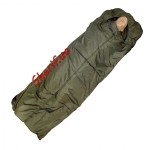 Прямокутний крій, застібка проходить збоку та знизу. Якщо повністю розстебнути, вийде звичайна підстилка. Він набагато зручніший для тих, хто любить розкинутися уві сні, проте важчий і займає більше місця. Ніхто не застрахований від поломки блискавки просто у поході. У такому разі спальний мішок такого типу можна використовувати просто як ковдру.
Прямокутний крій, застібка проходить збоку та знизу. Якщо повністю розстебнути, вийде звичайна підстилка. Він набагато зручніший для тих, хто любить розкинутися уві сні, проте важчий і займає більше місця. Ніхто не застрахований від поломки блискавки просто у поході. У такому разі спальний мішок такого типу можна використовувати просто як ковдру.
Іноді виділяють змішаний різновид, що є ковдрою з капюшоном.
4. Сезонність та температурні режими спального мішка
Універсальних спальників не буває. А бувають літні, зимові та міжсезонні (німецький демісезонник із чудовою фурнітурою та камуфляжним принтом «вудленд» для лісистої місцевості дивіться тут ). Відрізняються вони, певна річ, температурами, на які розраховані. І якщо Ви маєте намір ходити в походи в різні пори року, то, відповідно, Вам потрібні різні спальники . В іншому випадку Ви ризикуєте замерзнути. Причому в обох випадках: взимку в літньому - зрозуміло чому, а влітку в зимовому - укритим може бути нестерпно жарко, а зовсім неприкритим все ж таки прохолодно.
Цей розділ дуже важливо зрозуміти та запам'ятати. Тут є два головні терміни:
· Температура комфорту. У найсуворішому значенні це словосполучення означає нижню межу температури повітря, за якої можливий 8-годинний сон середньостатистичної жінки без пробуджень від холоду. Іноді на лейбах t комф вказується як діапазону. У такому разі верхня його межа - це t max , при якій можна добре спати в незастібнутому мішку, а нижня - t min , при якій досягнемо восьмигодинний сон середньостатистичного чоловіка без пробуджень від охолодження.
· Температура екстрим (екстремальна t ° C) . Не розібравшись у питанні, її можна переплутати з мінімальною комфортною, проте така помилка може коштувати дорого, тому – увага! Даний показник характеризує мінімальну температуру, за якої спальник допомагає вижити, захищаючи від гіпотермії (переохолодження). Тобто, це некомфортний 6-годинний сон без небезпечного погіршення термального стану людини. Наприклад, водозахисний Comfort Plus Olive WP , який пропонує магазин «Шериф», має textr −20 °C.
Вибираючи спальний мішок , накиньте до передбачуваної температури ще градусів 5-8 в дискомфортну сторону, шукайте спорядження з відповідними термальними параметрами. Крім того, бажано пам'ятати, що вони встановлені по-середньому, без урахування індивідуальних особливостей. Передбачається, що Ви здорові, добре харчуєтеся і не втомлені.
5. Розмір спального мішка
По-перше, переносні ліжка бувають односпальні та двомісні. Але останню версію важко назвати похідною, вона радше передбачає постійний табір. 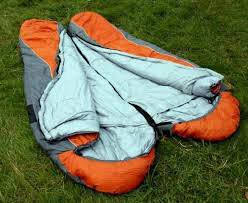 Хоча пари зазвичай розподіляють своє загальне спорядження на два рюкзаки, так що є можливість розмістити в одному громіздкий спальник, у другому – намет тощо. п. Але все ж таки любителям ночувати під однією ковдрою рекомендується взяти два спальники з опцією їх стеблення (на одному правостороння, на іншому лівостороння блискавка). На всякий випадок. Не дай Боже, один втратить функціональність чи загубиться, залишиться на пару хоч одне покривало.
Хоча пари зазвичай розподіляють своє загальне спорядження на два рюкзаки, так що є можливість розмістити в одному громіздкий спальник, у другому – намет тощо. п. Але все ж таки любителям ночувати під однією ковдрою рекомендується взяти два спальники з опцією їх стеблення (на одному правостороння, на іншому лівостороння блискавка). На всякий випадок. Не дай Боже, один втратить функціональність чи загубиться, залишиться на пару хоч одне покривало.
Одинарні спальні мішки бувають різної ширини, мають розміри, як у одягу: M, L, XL та ін. Однак вони, звичайно, не повинні облягати Вас, як водолазка. Особливо важливо, щоб було достатньо простору в області рук. І при злегка зігнутих колінах тканина не повинна сильно натягуватись.
Щодо довжини спального мішка, то не варто брати сантиметраж чітко під свій зріст. Краще додати ще близько 15 см. Але й не переборщити, бо в надмірно мішкуватому спальнику будуть додаткові тепловитрати.
6. Рекомендації щодо поводження зі спальним мішком у поході
Для тривалої та гарної служби спального мішка важливо знати та виконувати деякі нескладні правила його утримання.
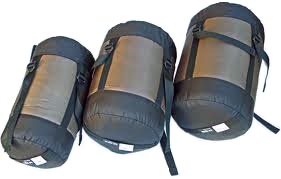 Насамперед, це стосується його укладання перед походом. Збирати його для нового переходу потрібно щоразу по-різному, хаотично, а не по одних і тих самих лініях згину. Не потрібно прагнути точнісінько повторювати строге і акуратне укладання, яке Ви бачили в магазині. Там це робиться для надання товарного вигляду. А якщо Ви складатимете так весь час, то пух/синтепон/вата збиватимуться в місцях вигину. Щоб заощадити місце у рюкзаку, використовуйте компресійний чохол.
Насамперед, це стосується його укладання перед походом. Збирати його для нового переходу потрібно щоразу по-різному, хаотично, а не по одних і тих самих лініях згину. Не потрібно прагнути точнісінько повторювати строге і акуратне укладання, яке Ви бачили в магазині. Там це робиться для надання товарного вигляду. А якщо Ви складатимете так весь час, то пух/синтепон/вата збиватимуться в місцях вигину. Щоб заощадити місце у рюкзаку, використовуйте компресійний чохол.
Після кожної стоянки, перш ніж запакувати Вашу постільну білизну, обов'язково струсіть її, розвісьте та просушіть. На деяких зразках бувають спеціальні петельки. Готуючись до ночівлі, дістаньте спальник заздалегідь, також потрусіть, «спушіть» і постеліть за деякий час до того, як лягати. Це потрібно, щоб воно увібрало повітря, розправилося після стиснення, – так його теплові властивості стануть кращими. Обов'язково використовуйте каремат – це не лише додаткова теплоізоляція, а й вологоізоляція та захист від поривів. У деяких мішках є спеціальна кишеня, в яку вставляється каремат, щоб уві сні не скочуватися з нього.
Деякі мандрівники люблять укладати спальний мішок у рюкзак планшетом без компресійного мішка. Це надає спинці рюкзака м'якість і зручність при переносі. Але в такому разі Ви ризикуєте зіпсувати спальник. Разом із спальним мішком там можуть опинитися продукти харчування, кетчупи, тюбики з мазями від комарів або гострі предмети (сокира, ножівка або ін.). І не факт, що все це Ви донесете у тому вигляді, в якому вкладали, без шкоди для спорядження.
7. Рекомендації щодо догляду та зберігання спального мішка
Ніколи не зберігайте спальний мішок у чохлі, що стискає – це може зіпсувати його за пару місяців. Розгорніть його, розправте і складіть у звичайний мішок і помістіть у сухе негаряче місце.
Після кожного походу провітрюйте його щонайменше добу. А ось прати щоразу не обов'язково. Тільки коли він став неприємно пахнути чи бути помітно брудним. Для середнього туриста десь на рік. І пам'ятайте: по-перше, жодної хімчистки, а по-друге, ніякого віджиму. Переважна взагалі ручне чищення зі спеціальними засобами. При цьому діставати випрану річ треба дуже обережно, щоб власна вага матеріалу, що набрав води, матеріалу не порвав її.
Для просушування краще не вішати, а розкласти на підлозі (щоб вода скла, спочатку можна покласти на ґрати над ванною або тазом). Якщо зовнішній матеріал спальника вологозахисний (наприклад, у мішка Мілітарі Камо вона витримує без протікання тиск 2000 мм водяного стовпа), оновіть його після сушіння спеціальним просоченням.
8. Рекомендації для покупців (як вибрати спальний мішок)
Сподіваємося, як вибрати спальник за призначенням, розміром, формою, сезоном, температурним режимом та утеплювачем, Ви вже зрозуміли, прочитавши відповідні розділи вище. Проте є ще на що звернути увагу.
Має значення гарна якість швів, тобто вони повинні скріплювати не лише зовнішню та внутрішню тканину, але й фіксувати положення утеплювача між ними. Отже, через весь периметр обох сторін спальника повинні проходити міцні рядки. Переконайтеся, що є. При цьому один рядок не повинен пришивати утеплювач до внутрішньої та зовнішньої тканин одночасно, інакше в місці такого шва будуть великі тепловтрати.
Зсередини блискавка-застібка має бути із запасом прикрита смужкою тканини з утеплювачем, щоб лінія застібки не стала щілиною, що пропускає холод.
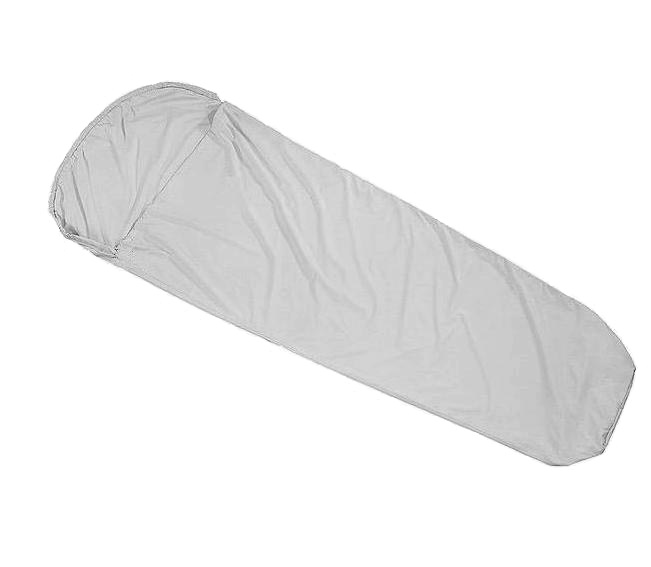
Помацайте також внутрішній матеріал: чи приємний він на дотик, адже Вам доведеться торкатися його уві сні тілом та обличчям. Втім, якщо це єдиний недолік обраного Вами виробу, то його легко виправити бавовняним постільним вкладишем.
Зовнішній тканини за певних умов походу бажано мати вологовідштовхувальні властивості. Звичайно, немає на увазі, що Ви повинні будете лежати в калюжі і не промокнути. В даному випадку йдеться про те, щоб при підвищеній вологості повітря не допустити зволоження наповнювача і, таким чином, втрати ним його властивостей, що утеплюють. 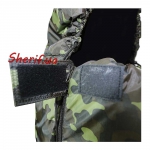
Зручність користування спальником буде вищою, якщо у нього буде гарна фурнітура: петельки для розвішування на просушування, автозатяжка біля каптура, двостороння «собачка», що розстібається як зовні, так і зсередини, якісна липучка, що перешкоджає відкриттю блискавки.
9. Де придбати спальні мішки недорого.
У Дніпропетровську придбати туристичні та тактичні спальник та за оптимальними цінами пропонує «Шериф». Ви можете знайти нас за фізичною адресою: вул. Артема, 9 або віртуальному https://sherif.ua, зателефонувати за міським телефоном 0562-318-600 або мобільним 063-798-9999, щоб дізнатися про діючі знижки та зробити замовлення, включаючи доставку по Україні в будь-яке місто: Житомир, Полтаву , Черкаси і т.д. буд.
(068) 798-0000 (063) 798-9999 (068) 300-5000
(068) 300-5000











